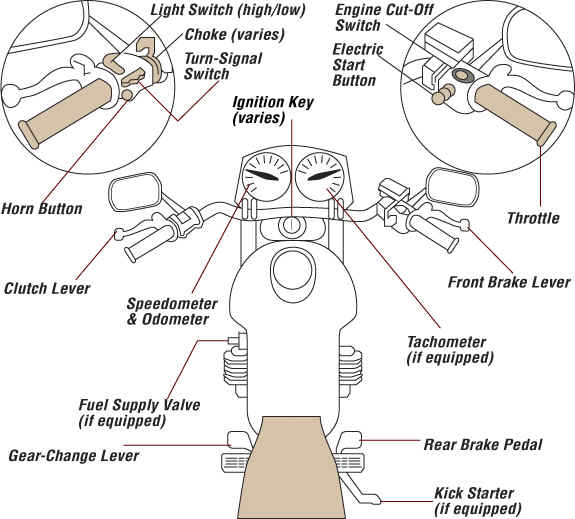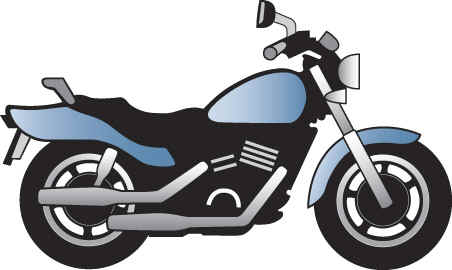Knowing Your Motorcycle | |||
Choosing the right motorcycle  | |||
When choosing a motorcycle, a rider should consider what type of riding will be done, as well as the level of experience and skill. It is important that a motorcycle fits a rider properly. The rider should be able to:
Know what type of riding you plan to do and choose a motorcycle that is designed for that purpose and your budget. | |||
| Get familiar with the motorcycle controls You should be completely familiar with the motorcycle controls before you take it out on the street. This is particularly important when riding an unfamiliar motorcycle. Be sure to review the owner’s manual.
| |||
Before riding a motorcycle, do the following:
| |||||||||
You should make a complete pre-trip inspection of your motorcycle before every ride. The following information will provide the essentials for an inspection, but you may want to develop your own way of inspecting a motorcycle. | |||||||||
| |||||||||
| |||||||||
• | Wire spoke wheels - check for damaged, missing or broken spokes, as well as spoke tension. |
• | Mag wheels - check for damage or cracks. |
• | Rims - check for damage. |
• | Chain - check for tension and lubrication. |
• | Belt - check for tension and wear. |
• | Shaft - check for oil leaks. |
• | Lights - check that the taillight and that both high and low beam headlights work. The headlight should come on when the motor is running. |
• | Brake light - check that both brake controls activate the light. |
• | Turn signals - test both signals by turning them on and off. |
• | Horn - try the horn to see if it is working. |
• | Engine cut-off switch - check that it works. |
• | Instrument lights – check they are working properly. |
• | Safety interlock switch on the side stand – check that it is working. |
• | Oil - check the oil level. |
• | Coolant - if the motorcycle engine is liquid cooled, check the fluid level, and check the hoses for cracks. |
• | Fuel - check that there is enough fuel for the trip. |
• | Leaks - check that there are no leaks on the ground under the motorcycle. |
• | Brakes - check that the brake fluid level is adequate and check hoses for leaks or cracks. |
• | Differential - check that the fluid level is adequate. |
• | Clutch - when squeezing the clutch lever, check that the cable moves freely and feels tight. If you have a hydraulic clutch, check for adequate fluid level. |
• | Throttle - check that it returns to the closed position easily, without assistance from the rider. |
• | Mirrors - make sure both mirrors are clean, properly adjusted and securely fastened. Adjust each mirror so you can see the lane behind, and as much as possible of the other lanes on the road next to you. When properly adjusted, a mirror may show the edge of your arm or shoulder. Remember that objects in your mirrors may be closer than they look. Never rely entirely on your mirrors. Shoulder check to see the traffic behind and to the side of you. |
• | Brakes - try both front and rear brakes one at a time, be sure each one feels firm and holds the motorcycle when the brake is fully applied. |
• | Center stand - check for cracks and bends, stand should be secure when retracted. |
• | Side stand - check for cracks and bends, stand should be secure when retracted. |




No comments:
Post a Comment